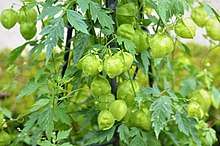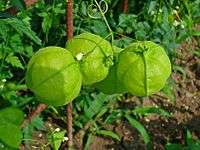Cardiospermum halicacabum
Cardiospermum halicacabum, known as the balloon plant or love in a puff, is a climbing plant widely distributed across tropical and subtropical areas of Africa, Australia, and North America.[1][2][3] It is often found as a weed along roads and rivers.
| Cardiospermum halicacabum | |
|---|---|
 | |
| Scientific classification | |
| Kingdom: | Plantae |
| Clade: | Tracheophytes |
| Clade: | Angiosperms |
| Clade: | Eudicots |
| Clade: | Rosids |
| Order: | Sapindales |
| Family: | Sapindaceae |
| Genus: | Cardiospermum |
| Species: | C. halicacabum |
| Binomial name | |
| Cardiospermum halicacabum | |
The 1889 book 'The Useful Native Plants of Australia' records that other common names for Cardiospermum halicacabum were "Broad-leaved Apple". J. E. Tenison-Woods records that the seeds can be eaten while the fruit was eaten roasted. The root is diuretic and demulcent. It is mucilaginous, but has a nauseous taste, and is used to treat rheumatism.[4] Sanskrit writers describe the root as emetic, laxative, stomachic, and rubefacient; they prescribe it in rheumatism, nervous diseases, piles, etc. The leaves are used in amenorrhoea. Rheede says that on the Malabar coast the leaves are administrated for pulmonic complaints. According to Ainslie, the root is considered laxative, and is given in dosages of half a cupful twice daily. "It would appear that in rheumatism the Hindus [sic.] administer the leaves internally rubbed up with castor-oil, and also apply a paste, made with them, externally; a similar external application is used to reduce swellings and tumours of various kinds. (Dymock.)"[2]
In New Zealand it is listed on the National Pest Plant Accord which identifies pest plants that are prohibited from commercial propagation and distribution. In Bermuda it is listed as a Category 1 Invasive Plant by the Department of Environment and Natural Resources[3]. Within the United States, four southern states (Alabama, Arkansas, South Carolina, and Texas) have all placed this plant on their individual noxious weed lists.[1]
It is one among the "Ten Sacred Flowers of Kerala", collectively known as dasapushpam.
Gallery
 Flower
Flower Unripe fruits
Unripe fruits Opened fruit showing seed arrangement
Opened fruit showing seed arrangement Seeds
Seeds
References
- "Plants Profile for Cardiospermum halicacabum (balloon vine)". plants.usda.gov. Retrieved 2019-05-29.
- J. H. Maiden (1889). The useful native plants of Australia : Including Tasmania. Turner and Henderson, Sydney.
- Pettit, Drew (2016). Bermuda's indigenous and invasive plants. https://environment.bm/in-the-library//updated-plant-finder-publication?rq=indigenous%20: Government of Bermuda. p. 118.CS1 maint: location (link)
- Treasury of Botany.
External links
- Dressler, S.; Schmidt, M. & Zizka, G. (2014). "Cardiospermum halicacabum". African plants – a Photo Guide. Frankfurt/Main: Forschungsinstitut Senckenberg.
- "Cardiospermum halicacabum L." Atlas of Living Australia.
![]()